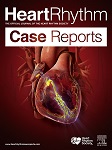This article has multiple issues. Please help improve it or discuss these issues on the talk page . (Learn how and when to remove these messages)
|
 | |
| Discipline | Cardiology |
|---|---|
| Language | English |
| Edited by | T. Jared Bunch |
| Publication details | |
| History | 2015-present |
| Publisher | |
| Frequency | Monthly |
| Yes | |
| Standard abbreviations | |
| ISO 4 | HeartRhythm Case Rep. |
| Indexing | |
| ISSN | 2214-0271 |
| LCCN | 2016243299 |
| OCLC no. | 932851878 |
| Links | |
HeartRhythm Case Reports (HRCR) is an online-only, open access medical journal that publishes case reports, images, and educational articles in the field of cardiac arrhythmias and electrophysiology. HRCR is the second peer-reviewed journal from the Heart Rhythm Society and is published by Elsevier.
